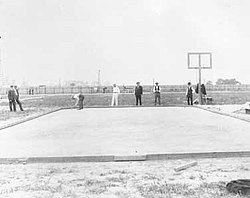First played 1880s | Team members 1-on-1 | |
 | ||
Highest governing body American Roque League (1916-1970s?)National Two Ball Roque Association (?-1970s?)National Roque Association (1899-?)National Croquet Association (1882-99) Venue Curbed clay court, with arches | ||
Roque sport
Roque /ˈroʊk/ is an American variant of croquet played on a hard, smooth surface. Popular in the first quarter of the 20th century and billed "the Game of the Century" by its enthusiasts, it was an Olympic sport in the 1904 Summer Games, replacing croquet from the previous games.
Contents
- Roque sport
- Sport 2011 colegio san roque
- Roque court and equipment
- Historical roque
- Contemporary roque
- References
Sport 2011 colegio san roque
Roque court and equipment
Roque is played on a hard sand or clay 30 by 60 foot (approximately 9 by 19 m) court bordered by a boundary wall, a curb bevelled at the ends to form an octagon. Players use this wall to bank balls similarly to how billiard balls are played off the cushions of a billiard table.
The wickets, called arches, are permanently anchored in the court. The arches are narrow as in professional six-wicket croquet. The court has ten arches in seven points configured in a double diamond (or figure-8). The two farthest end points and the central point of the figure-8 are double arches (one after the other) while the four side (or corner) points have single arches. Each arch of the double arches at either end of the court count as a separate arch, but the double arches in the center (which are closer together) are scored as a single arch. While in nine-wicket croquet the single central wicket opens up to the length of the court facing the stakes, in roque the double center arches face the sides of the court. Roque uses two stakes: at the head of the court is the "head stake," the other stake at the far end of the court is the "turning stake."
The mallets with which the balls are struck have a shorter handle (approx. 24 inches) than croquet mallets. One end of the mallet is surfaced with rubber, the other with wood, plastic, or aluminum.
Historical roque
The name "roque" was suggested by Samuel Crosby of New York City in 1899, who came to it by removing the initial "c" and final "t" from "croquet." The National Croquet Association, formed in 1882, thereafter changed its name to the National Roque Association in 1899. "Roque" is not to be confused with "roquet" /roʊˈkeɪ/, the term used in both roque and croquet for the bonus shot a player earns after striking another ball (on which he is not "dead") with his own.
The American Roque League was founded in 1916 and, after mergers with various other roque entities, became the centralized roque league on August 20, 1920. It last published its rules in the 1950s; the National Two Ball Roque Association last published its revised rules in 1961.
Contemporary roque
In 2004, the American Roque and Croquet Association suspended tournaments because the number of participants at the Nationals had shrunk to single figures.
Roque is still played by a small number of people in the United States. An historic roque court in Clinton, Illinois, was restored to playing condition in 2013. A roque tournament is held annually in Angelica, New York, USA.
